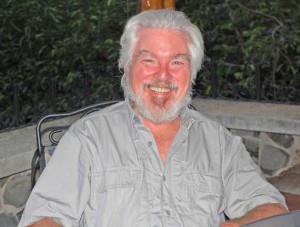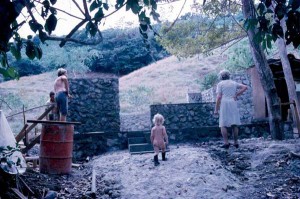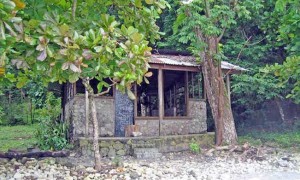Barry Biesanz
 Barry Biesanz pulls into my driveway, hops out of his car and wastes no time settling onto a patio chair for our interview. He does not need any prompting: he clearly has a message to share.
Barry Biesanz pulls into my driveway, hops out of his car and wastes no time settling onto a patio chair for our interview. He does not need any prompting: he clearly has a message to share.
“People ask me,” he says, “I bet you’ve seen a lot of changes here over the last 40 years. They assume they have all been for the worse – but they haven’t. Sure, there are some ill-conceived projects, drugs, prostitution and corruption. But there are far more monkeys than there were in 1971, and much more prosperity.” Most of Manuel Antonio, he continues, was being converted to pasture and crops, even much of what is now the park, and all the mangroves near town were cut to make charcoal.
“The United Fruit Company was the only employer aside from two huge and many small cattle farms. With the switch to tourism, forest cover increased and species that were been gone for decades have returned. Living standards are very much better for Quepeños.”
Barry’s parents, Mavis and John Biesanz, were anthropologists who came here from Minnesota in the 1940s with the idea of researching a little known country. They hitchhiked through Central America, ending up in Heredia. They began to write about Costa Rican customs and life, a project that eventually extended over three books, 55 years, and two generations, Costa Rican Life was published in 1944; The Costa Ricans in 1979 and The Ticos in 1999. Mavis also wrote many other books. “My father used to say that he’d been in over 100 countries, and Costa Rica was far and away his favorite,” Barry recalls.
Born in New Orleans, Barry first came to Costa Rica as a teenager in 1963 – the year that President John F. Kennedy visited and that Irazú Volcano erupted. Barry and his parents moved back to Costa Rica in 1971, all eventually becoming naturalized Ticos. On a trip in 1969 his father bought Punta Quepos from Willie Hug, the regional United Fruit Company manager, who John would say “ruled the area like a benevolent dictator… well, a dictator, anyway.” Barry settled on Punta Quepos, armed with a copy of The Last Whole Earth Catalog.
 “In those days it was a was a five hour ride on three different buses to reach Quepos from San José,” Barry recalls, “and it was a good hour’s walk from Quepos to Manuel Antonio.” Barry made the trip with his then wife, Cathy, and two year old son, Jeremy. They lived in an rustic shack on Playa Paraíso, later named Biesanz Beach (Playa Vizan on area buses). Barry carried ten gallons of water a day from a fresh water stream while Jeremy ran around naked in rubber boots. The little blond haired boy, “Jeremías “, as the locals called him, was a rarity in the area and very popular with the shop ladies at La Garza.
“In those days it was a was a five hour ride on three different buses to reach Quepos from San José,” Barry recalls, “and it was a good hour’s walk from Quepos to Manuel Antonio.” Barry made the trip with his then wife, Cathy, and two year old son, Jeremy. They lived in an rustic shack on Playa Paraíso, later named Biesanz Beach (Playa Vizan on area buses). Barry carried ten gallons of water a day from a fresh water stream while Jeremy ran around naked in rubber boots. The little blond haired boy, “Jeremías “, as the locals called him, was a rarity in the area and very popular with the shop ladies at La Garza.
“We made our lemonade from a tree growing into our kitchen,” Biesanz laughs. “When the lemons eventually ran out, we felt quite inconvenienced at having to go outside for more. I used to spear fish and catch lobster that we cooked on a wooden table full of sand. My wife got tired of eating lobster.”
Barry used to walk to Quepos for supplies, calculating what provisions were really essential because he had to carry them back. At night they would read by Aladdin lamps while vampire bats flew in and out. “The trick was to keep your toes covered,” he chuckles.
After about eight months of beach homesteading Cathy had had her fill of the wild. They rented a house in Moravia and Barry commuted back and forth to Manuel Antonio where he tried his hand at cattle ranching, planting soybeans and harvesting avocados. “The iguanas ate the soybeans and after a few years the monkeys came back and ate all the avocados. Tourism seemed the only answer, so I built two rustic cabins out of beach stones to rent. But no one in our family wanted tourism development to be at the expense of wildlife, so we started thinking of the farm as a place to plant trees, to feed monkeys, to attract tourists.”
Barry soon learned that land goes back to forest very unevenly unless you reintroduce what used to be here. “Passive reforestation doesn’t lead to diversity,” he says. “We went to Zoo Ave and asked about reintroducing macaws, and they said we would need to show that we had enough trees and palms to feed a macaw population. So that became a sub-project that is now literally bearing fruit.” Back then, he continues, there was little interest in forest restoration and almost all the literature was for conventional plantations. “Then we found a copy of The Ecology of a Tropical Forest, Studies from Barra Colorado Island in Panama, not too dissimilar to Manuel Antonio. This reported that only 5% of the trees fed about 90% of the birds and animals, so that made things easier – concentrate on those species.”
 Barry explains that the wildlife population had been severely stressed by land clearing and cattle ranching, exacerbated by the local practice of hunting. “Some people shot monkeys and macaws just because they could,” he says. “The whole relationship with Nature was very different back then. The forest was seen as a frightening place, full of snakes and dangers. Banks would not lend money to a farmer unless he improved the land – by cutting the forest – which was often burned or left to rot, for lack of roads and markets. Costa Rica was very lucky, in that the appreciation of wildlife and forests began to grow while there was still something left to protect. And creating the Manuel Antonio Park was a tremendous achievement.”
Barry explains that the wildlife population had been severely stressed by land clearing and cattle ranching, exacerbated by the local practice of hunting. “Some people shot monkeys and macaws just because they could,” he says. “The whole relationship with Nature was very different back then. The forest was seen as a frightening place, full of snakes and dangers. Banks would not lend money to a farmer unless he improved the land – by cutting the forest – which was often burned or left to rot, for lack of roads and markets. Costa Rica was very lucky, in that the appreciation of wildlife and forests began to grow while there was still something left to protect. And creating the Manuel Antonio Park was a tremendous achievement.”
So when Biesanz speaks of the positive impact of foreign influence he is speaking from experience. “The change in prosperity is striking,” he says.“In the old days a dog could sleep in the middle of the road in Quepos uninterrupted. You had to travel on washboard, dusty roads, with 33 rickety one-lane bridges between Quepos and Parrita.”
He remembers how his farm worker’s daughter was diagnosed with polio, and sent home from the hospital untreated, with a bag of penicillin ampules for home injection. A peon made 102 colones a week, about $12. There was still malaria. The howler monkeys in the area were wiped out by yellow fever in the 1950s. “They were reintroduced here recently,” he remarks, “and I don’t think that would have happened without tourism. People often complain about foreign development but it saved Manuel Antonio.
Biesanz argues that many in the environmental movement exaggerate the damage done by tourist development to raise funds, yet uncontrolled agriculture without proper zoning has done far more damage, with less economic benefit per land unit. “There is a nationalistic and anti-capital element in much of the ostensible environmental opposition,” he argues, “and you have circuses like the hysteria over Arenas Del Mar, one of the best designed and greenest projects in the country.”
In addition to planting trees on his property, Biesanz started two non-profit nurseries in Manuel Antonio and San José to encourage people to purchase and plant species for the habitat restoration of wildlife. He supplies them to schools and non-governmental organizations free of charge and for only $1.00 per tree to the public. (Anyone wishing to see the nurseries or purchase trees should contact Ramon Espinoza at 8390-8250.)
Based on the reforestation of Punta Quepos, Biesanz was invited to join the group, composed of representatives from the parks, MINAET, ICE, private reforesters, and rural associations working to establish biological corridors linking the parks and protected areas of the Central and South Pacific coasts, called the Paso de la Lapa, or Path of the Macaw. “I’ve met a lot of interesting people who are very serious about getting this done, both for its own sake, and as a means of bringing small scale eco-tourism to their rural villages,” he says. “It turns out that there are significant populations of Titi monkeys outside Manuel Antonio that just need a little help to reunite with other populations.”
Since the mid-1970’s, Barry has also learned and practiced woodworking, concentrating on high quality craftsmanship and the use of local woods, especially cocobolo and lesser known species. He has a successful business, Biesanz Woodworks, in Escazú which sells exquisite boxes of all kinds – jewelry boxes, some with roll tops, humidors, cremation urns, even condom boxes.
Biesanz displays his products in galleries throughout Costa Rica and internationally. They can also be ordered from the Biesanz Woodworks website, biesanz.com. His wooden treasures adorn the homes of many famous people including the Pope, the Queen of Spain, four United States Presidents and other heads of state.
Barry has continued to pursue music and started his own band, “Harmony Roads”, that entertains in San José. He unwittingly gives me a sample of his talents when he breaks into the national anthem after telling me he became a Tico eleven years ago. He is clearly an avid reader, citing book after book he considers “must reads”, especially on nature, entrepreneurship and the environment.
I ask about his dream for the future of his much-coveted oceanfront property. He says that the tip of Punta Quepos is primary forest and it will stay that way. The rest, he says, is secondary forest or a mixture, and he could envision half of it dedicated to low impact environmental tourism, the rest a reserve.
“There are more environmentalist developers now,” he says, and gives some examples. “I could imagine a botanically themed project with light structures, little or no earth moving, electric carts, raised walkways and filtered views like those of Makanda and Mango Moon. No golf! There is nothing like that in the country and it could be a real jewel.”
Barry has three children who have evidently inherited the Biesanz creative and academic propensities. Jesse, the oldest, who went to school in Escazu and ran the first horseback tours in the Manuel Antonio area, is now a successful stoneworker in Oregon with his own company, Biesanz Stoneworks. Jeremy is a research psychologist at the University of British Colombia, and Jana, his only daughter, is a creative writer living on the East Coast. He and his second wife, Sarah Blanchette, have six grandchildren.
